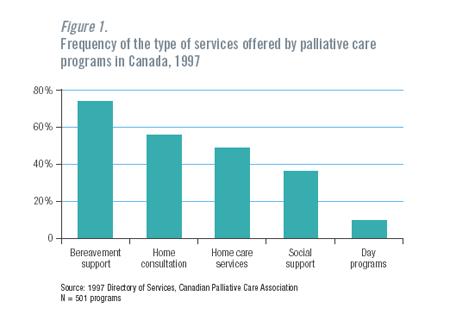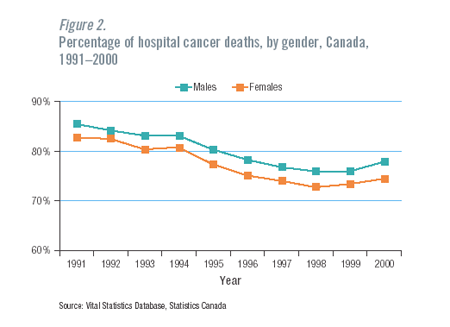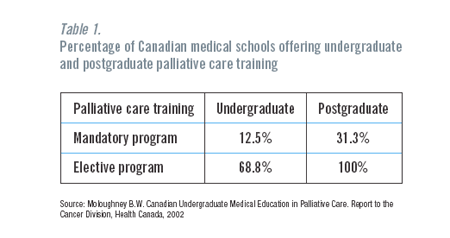Common menu bar links
Institutional links
Diseases & Conditions
Health & Safety
Research & Statistics
Agency Information
Search Box
E-mail this page
Progress Report on Cancer Control in Canada
[Previous] [Table of Contents] [Next]
Palliative Care
Palliative care has recently been defined by the World Health Organization as “an approach that improves the quality of life of patients and their families facing the problem associated with lifethreatening illness, through the prevention and relief of suffering by means of early identification and impeccable assessment and treatment of pain and other problems, physical, psychosocial and spiritual.” The distinction between palliative care and hospice care is often unclear; in Canada, they are often frequently interchangeable. Some would distinguish hospice care as that which is offered in the community rather than in hospitals.
Palliative care and Canada’s aging population
Most palliative care in Canada is provided to patients who have received a diagnosis of cancer. Strategies for supporting and sustaining effective palliative care services will become increasingly important as Canada’s population grows and ages. The Senate Subcommittee Report, Quality End-of-Life Care: The Right of Every Canadian, released in June 2000, recommended increased availability of and improved access to services delivered by qualified, interdisciplinary palliative care teams.
The Senate Committee Report also recommended the development of a Canadian Strategy on Palliative and End-Of-Life Care. A Secretariat on Palliative and End-of-Life Care was established in June 2001 within Health Canada to facilitate and coordinate the development of the Strategy. As a first step in strategy development, Health Canada sponsored a national action planning workshop in March 2002. This event brought together 150 experts and stakeholders to discuss priorities and make recommendations on moving forward. The five key areas of focus were identified as: best practices and high-quality care; public information and education; education for care providers; research; and surveillance.
Working groups corresponding to each of these areas were established and are being supported by the Health Canada Secretariat on Palliative and End-of-Life Care. The groups are chaired by individuals recognized for their expertise, experience and leadership qualities. Members of each group represent the broad spectrum of palliative and end-of-life care. The Canadian Strategy will reflect a holistic approach and will include broadly accepted core principles. It will also provide an integrated conceptual framework for palliative care and suggested approaches for various aspects of this care, such as clinical practice, pain and symptom relief, surveillance, technology use and assessment tools. The Strategy will also address the particular palliative care needs of specific groups of Canadians, including, for example, immigrant communities, Aboriginal peoples and persons with disabilities.
The Secretariat on Palliative and End-of-Life Care continues to build on the identified priorities in its work, emphasizing collaboration with key stakeholders on this issue. It is working to ensure that palliative care is taken into consideration in all relevant policy initiatives at Health Canada and throughout the federal government. At the same time, palliative care has been identified as one of the five priorities of the Canadian Strategy for Cancer Control. Researchers are also making a priority out of determining how palliative care can be delivered more effectively to cancer patients in need.
Integration of palliative care services
Traditionally, palliative care has been provided by family members. Formalized palliative care in Canada began in 1974–1975 at teaching hospitals in Winnipeg and Montréal. Unlike the traditional models of private hospices developed in the U.K., and then in the U.S., Canadian palliative care services tend to incorporate a palliative consultation team within institutions and home care services. Today, these programs continue to evolve and are increasingly integrated across a variety of institutional and community-based health care settings. Although hospice care is usually provided in the patient’s home, care is also provided in freestanding hospice centers, hospitals, and nursing homes and other longterm care facilities. While individual programs vary, most aim to provide a comprehensive range of services using an interdisciplinary team approach that involves doctors, nurses, pharmacists, social workers, spiritual advisors and volunteers. It has also been increasingly appreciated that palliative care services do not just have an endof- life role, though that becomes increasingly important with time. Palliative care should be available from the beginning of treatment, especially for those recognized as not eligible for curative therapy.
Palliative care programs
Palliative care programs in Canada offer a comprehensive range of services that may include: 1) relief from pain and other symptoms; 2) psychological and spiritual care; 3) a support system to help patients live fully until death; and 4) support and bereavement for families. According to surveys conducted by the Canadian Hospice Palliative Care Association (CHPCA), the number of palliative care programs has increased steadily — from 118 programs in 1981 to more than 600 in 2002. In 1997, the majority of these programs offered bereavement support services, and about half provided home consultations by a health care professional and home care. However, relatively few programs delivered day programs for respite or hospice care (Figure 1).

Creating options for patients
Given the option, many people would prefer to die at home. Traditionally, a dying cancer patient spends his or her last few months in hospital, often relatively isolated from loved ones. A home death provides an atmosphere of comfort among people and surroundings that are familiar. The percentage of hospital cancer deaths has generally been in decline since the early 1990s (Figure 2). However, currently, more than three out of four Canadian cancer patients die in hospital. With the implementation of a comprehensive regional palliative care program, more cancer patients should have the option of dying at home.

In Edmonton, such a program was established in 1995–1996, and this has led to a number of changes. The proportion of terminal cancer deaths occurring in acute care hospitals has been reduced from 86% to 49%, and the proportion of home deaths has increased from 10% to 21%. The proportion of terminally ill cancer patients receiving palliative care rose from 23% to 84%. The number of inpatient hospital days has also dropped dramatically, from 24,566 to 6,960 days, reflecting a shift to treatment provided in hospices and at home. As experience suggests, such shifts benefit patients and their families and should be encouraged. One important consequence would be a switch of resources, given that funding for hospitals and home care tends to come from different budgets.
Applying palliative care principles to childhood cancer
The majority of children with cancer in Canada will survive their disease, but the treatments and procedures involved in curing them can be painful and may have a negative immediate impact on quality of life. Applying the principles of palliative care, such as good pain and symptom management and psychosocial support for the child and family from the time of diagnosis, can assist in improving the quality of life for children with cancer.
Chronic and often terminal pain requires multidisciplinary pharmacological, behavioural and nursing support that can often be delivered to children in the home using long-acting opioids and symptom control. Rehabilitation services also have a role for those who experience complications from treatment. For example, there is a Pediatric Palliative Care Service in Halifax, which consists of a full time physician and clinical nurse specialist who, through consultations, assist the oncology team in providing care to children and families. The service has worked with 89 families over a 4-year period (January 1998 to January 2002). Generally, the service is consulted when there are hard-to-manage symptoms or when the child and family wish to receive end-of-life care at home or at a hospital located closer to home.
Providing pain relief to those with cancer
The World Health Organization has promoted a three-step analgesic “ladder” to recognize the increasing requirements for pain relief of many patients as their disease progresses. Drugs of the non-steroidal anti-inflammatory class (NSAIDs) such as Aspirin® and analogues may initially suffice. If pain becomes more severe, however, an opioid for mild to moderate pain, such as codeine, should be prescribed. If this fails to relieve the pain, there should be no hesitation in prescribing morphine, usually in its orally administered form.
There is no standard dose for opioid drugs — the “right” dose is the dose that relieves the patient’s pain. Regular provision of morphine is essential for adequate pain relief, and the schedule of administration required should be determined for each patient. While palliative care specialists understand this requirement, other health care professionals, both in hospital and at home, may need special instruction to ensure that unrelieved pain does not occur. It has been estimated that 30% or more of cancer patients suffer from unrelieved pain, and thus it should be a priority in all areas of Canada to reduce this to the absolute minimum. It was estimated from a study in the United States that relief from cancer pain can be achieved in about 90% of patients.
Medical training in palliative care
Palliative care requires specialized training in addressing pain and discomfort. It also requires a thorough understanding of the physical, emotional, social and spiritual impact of dying on the individual, family and friends. In spite of these requirements, some health care professionals are not adequately trained to recognize and manage cancer-induced pain. In 2002, there were 165 palliative care specialists in Canada who were members of the Canadian Society of Palliative Care Physicians. The availability of these physicians varies by region, although differences may occur because not all qualified physicians are members of this association, especially in Quebec. Palliative care may also be delivered by trained family practitioners, by specialists in other medical disciplines and, both in hospital and at home, by specially trained nurses.
In a survey of physicians who identified themselves as being involved in pain management, palliative care or oncology, 28% rated their pain management training as poor, and only 5% rated it as excellent. Of the oncologists surveyed, 73% ranked their graduate training in pain management as fair or poor. Survey respondents indicated that the limiting factor in pain management is not the unavailability of analgesics, analgesic techniques or tools, but the underuse of these techniques.
In 1991, the Canadian Palliative Care Curriculum was published and distributed to all Canadian medical schools. Designed specifically for undergraduate medical training, the curriculum outlines the objectives of palliative care instruction. Despite this incentive, palliative care instruction appears to be minimal.
To assess the current state of palliative care instruction, all 16 medical schools in Canada were surveyed (Table 1). Most of the schools offered elective programs in palliative care, but only a small proportion of students participated in these programs. Only two of the undergraduate programs and five of the graduate programs had mandatory training in palliative care. For undergraduate medical programs, 15 of the schools surveyed offered an average of 11 hours of instruction. Most of this curriculum was taught by full-time palliative care specialists, and the training occurred during the first two years of medical school. The curriculum included pain assessment and management, with an emphasis on development of communication skills. This current, somewhat restrictive level of palliative care training in Canadian medical schools may limit the ability of physicians to adequately identify and deal with issues of pain and suffering in their patients.

Future challenges
Medical and nursing training
As Canada’s population rapidly ages, there is a critical need to address inadequacies in medical and nursing training for palliative care, particularly in pain control and management.
Currently, there are insufficient programs in place to train all needed health care workers. However, the CHPCA recently completed development of a training program that could have a significant impact on palliative care across Canada. The Palliative Care for Support Workers Training Program has trained more than 2,100 support workers in five different provinces. In addition, 140 health care practitioners have been trained as palliative care instructors for future training programs. As a result, new training programs are being established in Alberta, Manitoba, Ontario, Prince Edward Island and Newfoundland and Labrador.
Data collection and palliative care integration
There is also a critical need to collect surveillance data, evaluation indicators and performance measures to help facilitate the integration of palliative care programs across Canada. This integration is essential because common tools are crucial to planning, evaluating and monitoring appropriate care at the end of life to ensure that optimal services are available to provide high-quality, end-of-life care to all Canadians dying of cancer.
Regional data should be collected on the extent to which pain is relieved, and remedial action should be taken if the findings are unacceptable. This may require special research projects to determine how pain control may be most effectively delivered.
A palliative care directory is being established in response to this need. The Canadian Directory of Hospice Palliative Care Services was developed to collect relevant information from all hospice palliative care programs that offer services across Canada (in all provinces and territories), including hospital, hospice and communitybased services provided to patients and families regardless of diagnosis or disease. Statistics collected include the number of programs in Canada and where they are located, the number providing various services and the types of patients served, and estimates of approximate case-loads, capacity and annual numbers of patients.
[Previous] [Table of Contents] [Next]
